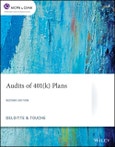Table of Contents
Chapter 1 1-1
Introduction and Background 1-1
Background information 1-3
Operation and administration 1-6
Accounting records 1-8
Reporting standards 1-10
Governmental regulations 1-11
Audit requirements 1-12
Reporting and disclosure requirements under ERISA 1-16
SEC Form 11-K filing requirements 1-17
ERISA limited-scope audits 1-19
Chapter 2 2-1
Planning 2-1
Pre-engagement activities 2-3
Audit planning 2-6
Communication and coordination 2-10
Understanding the plan and its environment, including its internal control 2-11
Audit documentation 2-13
Preliminary analytical review procedures 2-14
Audit risk factors 2-15
Internal control structure 2-21
Consideration of fraud 2-22
Plan’s use of third-party service organizations 2-29
Party in interest transactions 2-30
Plan’s use of voice response or internet recordkeeping system 2-32
Accounting estimates 2-33
Going concern considerations 2-34
Chapter 3 3-1
Internal Control Structure 3-1
Understanding internal control 3-4
The components of internal control 3-6
Acquiring knowledge of the controls 3-9
Assessing control risk 3-10
Plan’s use of third-party service organizations 3-11
Plan’s use of voice response and internet-based recordkeeping systems 3-16
Documentation 3-17
Communicating control deficiencies 3-18
Chapter 4 4-1
Auditing the Statement of Net Assets Available for Benefits 4-1
Accounting guidance 4-3
Listing of investments 4-4
Valuation of investments 4-5
Investment options 4-6
Audit objectives 4-8
Audit procedures 4-9
Investments in master trusts and similar vehicles 4-11
Investments in registered investment companies (mutual funds) and common or commingled trust funds 4-13
Investments with insurance companies 4-15
Direct filing entities (DFE) 4-20
Other investments 4-21
ERISA limited-scope auditing procedures 4-24
Contributions receivable 4-26
Notes receivable from participants receivable 4-27
Cash balances 4-29
Other assets 4-30
Accrued liabilities 4-31
Chapter 5 5-1
Auditing the Statement of Changes in Net Assets Available for Benefits 5-1
Investment income 5-3
ERISA limited-scope audit 5-7
Investment expenses 5-8
Contributions from employers 5-9
Individual participant accounts 5-12
Participant eligibility 5-17
Contributions from other identified sources 5-18
Withdrawals 5-19
Loans 5-20
Administrative expenses 5-22
Chapter 6 6-1
Other Auditing Considerations 6-1
Plan tax status 6-2
Testing for discrimination 6-7
Consequences of violations 6-8
Failure to pass nondiscrimination tests 6-9
Commitments and contingencies 6-10
Subsequent events 6-12
Representations from plan management 6-14
Illustrative attachment to management representation letter 6-18
Form 5500 and supplemental schedules 6-21
Information for supplemental schedules from trustee or custodian 6-28
Terminating plans 6-32
Plan mergers 6-35
Party in interest transactions 6-36
Initial audit of the 401(k) plan 6-41
Form 11-K: The Sarbanes-Oxley Act of 2002 6-44
Communication with those charged with governance 6-47
Chapter 7 7-1
The Auditor’s Report and Financial Statement Disclosures 7-1
The auditor’s report 7-4
Standard report 7-7
Additional communications: Emphasis-of-matter and other-matter paragraphs 7-10
Modified reports 7-12
Non-GAAP basis financial statements 7-14
Reports filed pursuant to the SEC Form 11-K 7-16
ERISA limited-scope reports 7-21
Financial statement disclosures 7-24
Appendix A A-1
ERISA and Related Regulations A-1
Appendix A A-3
Glossary Glossary 1
Index Index 1
Solutions Solutions 1
Chapter 1 Solutions 1
Chapter 2 Solutions 4
Chapter 3 Solutions 6
Chapter 4 Solutions 8
Chapter 5 Solutions 10
Chapter 6 Solutions 12
Chapter 7 Solutions 17








